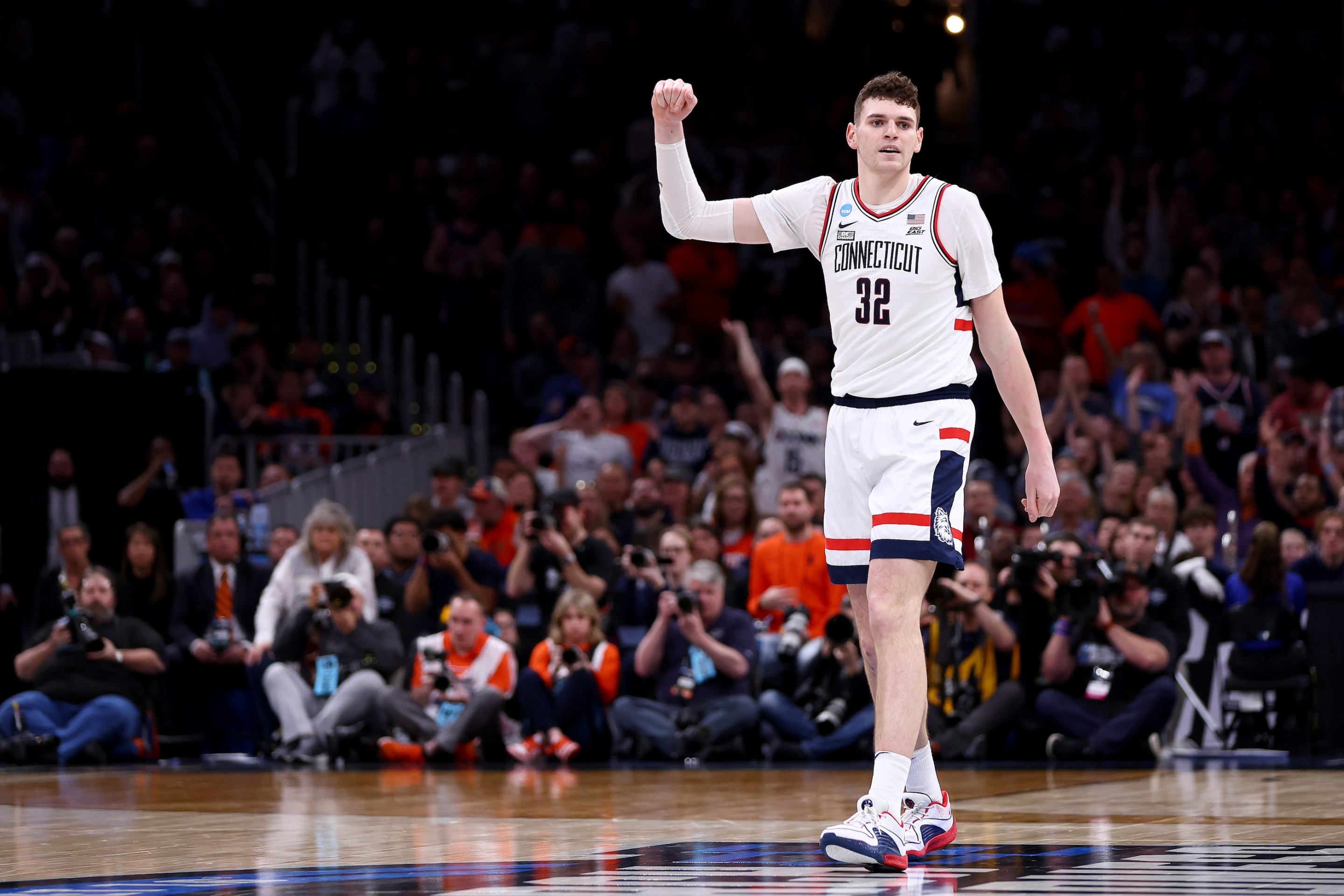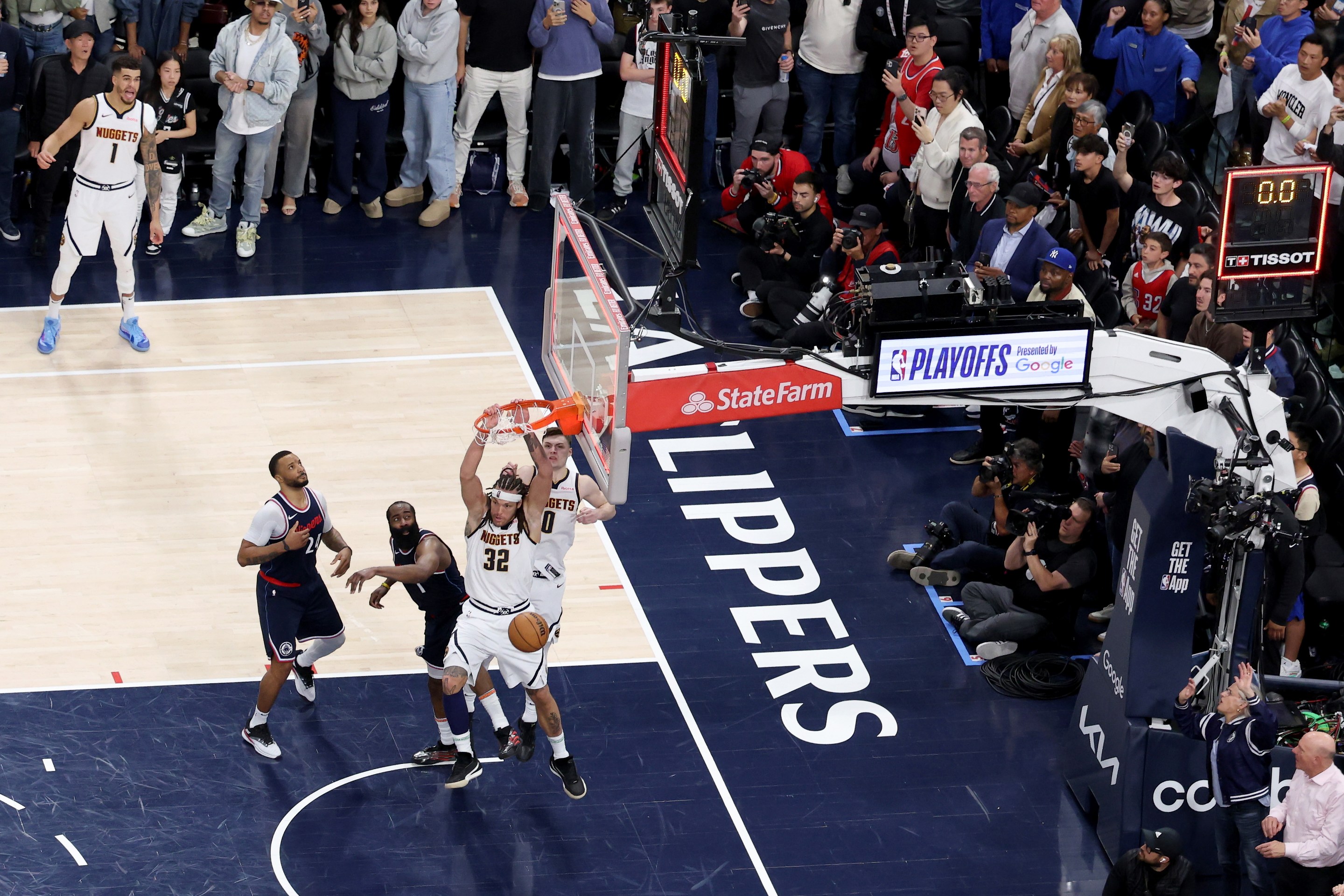BOSTON — If you are looking for the point at which the University of Connecticut turned their East Regional final from a rout into a front-hall exhibit at the Smithsonian Museum of American Ass-Kicking, try the 17:12 mark of the second half. The Huskies were just at the beginning of the ludicrous 30-0 run they put on Illinois; at that point, UConn was only up by 10. Illini forward Quincy Guerrier rose up from the right baseline, cocked the ball behind his head for a SportsCenter highlight dunk, and … nothing.
Donovan Clingan, Connecticut’s huge and ever-improving center, met Guerrier in midair and absolutely stuffed, erased, and hijacked Guerrier’s big moment, to say nothing of his shot. Power to power, Guerrier never had a chance. Clingan then ran the floor and dunked at the other end. The air went out of the Illini so quickly that it’s a wonder that all of its players didn’t fly around the court backward for 20 seconds before collapsing in a heap at midcourt.
The lead grew by great gouts of points, and Clingan was in the middle of all of them. He scored, and rebounded, and passed. On one memorable possession, playing the point on the press, Clingan picked an Illinois dribbler clean and got a teammate a layup. The UConn center had to bend down like Gulliver to make the steal, and you could almost hear the ring-a-ding-dinging of the cash machines in Adam Silver’s mind.
But what Clingan mostly does, and mostly did, was defend. He turned the lane into the Gorge of Eternal Peril. Illinois players who drove to the bucket either looked to pass in midair, or attempted hopeless layups while doing the seven basic ballet moves. This was some straight-up Bill Walton shit, and it got UConn its 77-52 win.
“Really in the second half, the way we were moving the ball on offense and how we were playing for one another really just opened up opportunities to dominate in the post and find cutters cutting and getting open shots,” Clingan said afterward. “Just one thing about this team is we always play for the guy next to us. We're not worried about our stats. We're not worried about self. We're worried about the person next to us, worried about the team, and worried about walking out with a W.”
That Clingan took over in the East was of a piece with the entire tournament. It’s been a festival for big humans. In the Final Four, besides Clingan, there’s Zach Edey, the Ent from Purdue, and North Carolina State’s D.J. Burns Jr., who is the tournament’s entire personality wrapped up in a nouveau Barkley package. This is in keeping with the fact that this has been the most Let ‘Em Play tournament since Bob "Foothills" Kurland was tearing it up for Oklahoma A&M back in the 1940s. The area under the basket has not been a place for the faint of heart since these brackets opened for business. Whether this was a decision anyone made or just a function of the way the teams fell out, the result has been a playground for old-fashioned, butt-in-your-guy post play.
As for UConn, the program has spent two years making a mockery of this whole event. Counting last year’s championship run, the Huskies have won nine tournament games in a row by an average of almost 23 points a game. In its first three games of this tournament, UConn won by a total of 86 points. Its 30-point win over San Diego State in its first game in Boston was the largest margin of victory in a regional semifinal since 2017.
“We just had tremendous respect for Illinois,” UConn coach Dan Hurley said. “Brad [Underwood] and their program and the team, I obviously would have been thrilled just to get out of here with a win. But our defense is elite. Our offense is elite. We rebound the ball. These guys play every possession like it's the end of the world. [Assistant coaches] Kimani [Young] and Luke [Murray] prepare these guys with scouts at a quality level that any head coach in the country would be proud to put forth. Those two guys are amazing. We've got NBA-level players that are just willing to share and have created an unbelievable culture. We're going to be tough to beat.”
Even if he does say so himself.
I wish I liked UConn’s team as much as I admire it. But there’s a fine line—I call it The Laettner Meridian—when entertaining swag tips into privileged posing, and Hurley and his team flirt regularly with it. At one point after Illinois had long since been turned into roadkill, Hurley walked out onto the floor to gin up his adoring fan base, which hardly needs ginning on its most apathetic day. (Note to the good folks in Glendale, Arizona: Prepare for lots of noisy people in blue windbreakers and Foxwoods hats this weekend.) Guard Cam Spencer has in him more than a little Grayson Allen, except for the conspicuous nut-shots.
But there’s no question that UConn has owned the NCAA men's tournament, and that it has done so playing the kind of basketball that people who love basketball love to watch. This includes me, and has included me for over 60 years. In watching them, I saw glimpses of other great basketball I’d seen played around this time of year. Mainly, I remembered the 1990 NCAA final game in which UNLV had run Duke to pieces in Denver. (The game is partly forgotten because Duke upset UNLV in Indianapolis the following year; that one is celebrated all out of proportion compared to the year before, when UNLV wasn’t playing with the NCAA on its back all season.) The Rebels seemed to spend most of the second half of that game in a permanent fast break that always began with a steal and always ended in a dunk. They put up 56 points in the half and won the game by 30. What Connecticut did to Illinois on Saturday was the closest thing I’ve seen to that fireworks display since.
During that UNLV game, I was sitting next to a prominent college coach whose team had lost to Duke earlier in the tournament. As Duke’s Mike Krzyzewski called one futile timeout after another, trying to hold back the resistless tide, my seatmate had a quizzical look on his face. I asked him what was wrong.
“I could have been down there,” he said. “And, I don’t know, I think I’d have to have someone start a fight.”
A fight, I asked.
“Hey,” he said. “Sometimes you need a diversion.”






